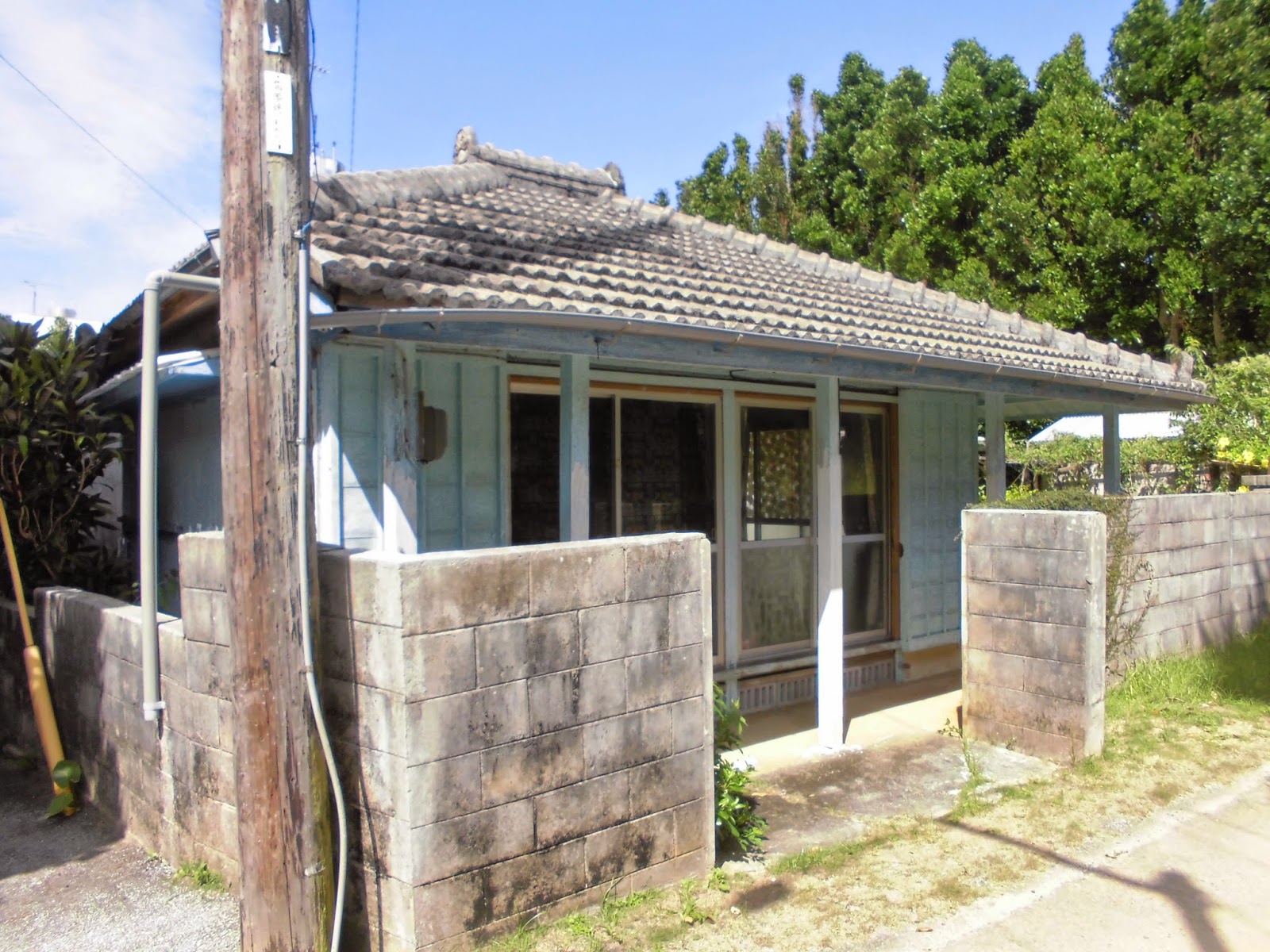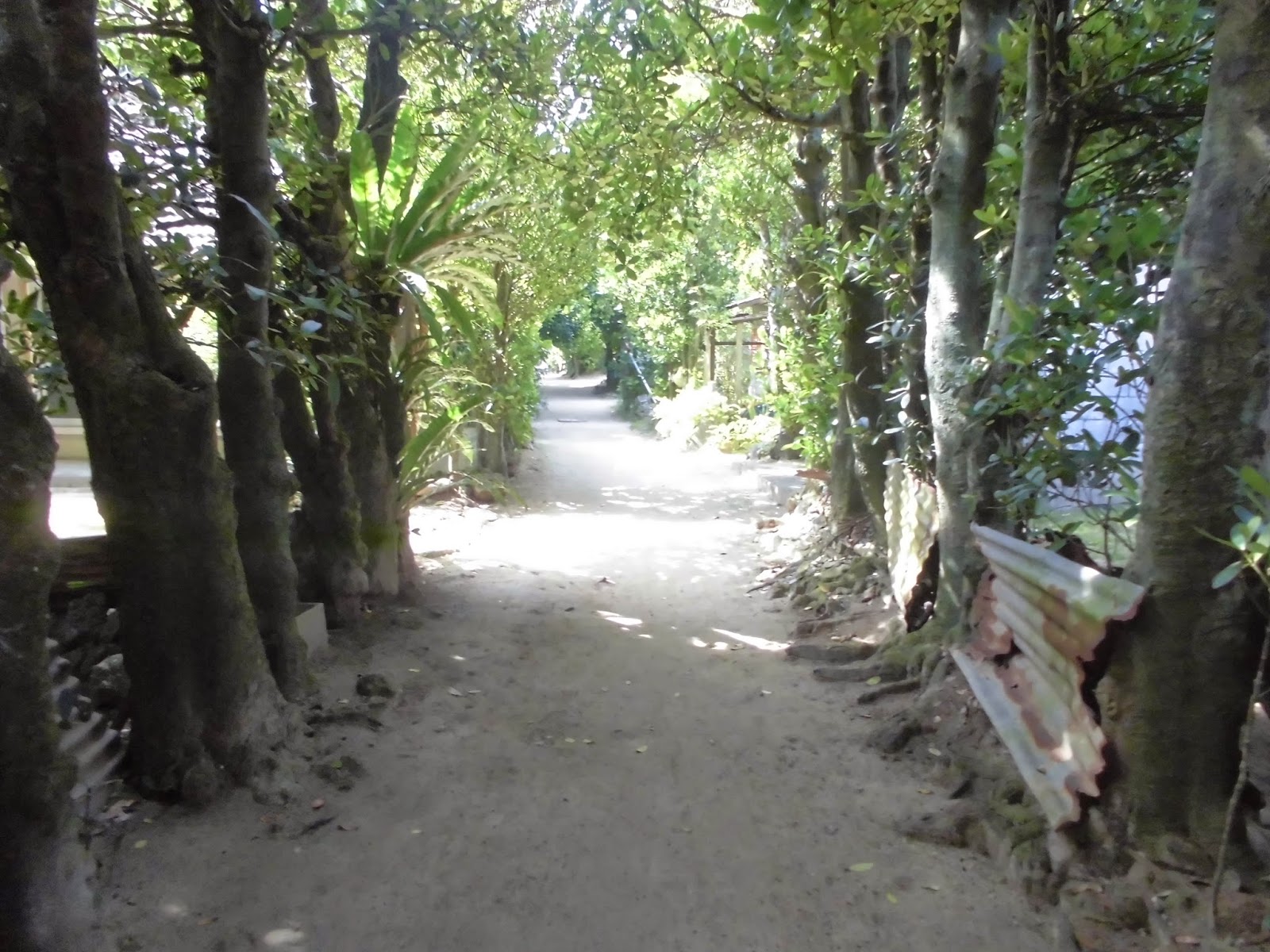And now for our last Okinawa story! After leaving Nakijin Castle, I went to Bise, a small village in Motobu Town. This neighborhood has signs in it to guide people around, but it's not just a tourist location; people actually live here. Why is the neighborhood such a popular tourist destination? The area is planted with lots of fukugi trees (garcinia trees), and the roads are unpaved, sand paths. It's very beautiful, and very practical as well. The neighborhood is on the coast, and fukugi trees act as natural buffers to the wind. Additionally, they provide a lot of shade, and it was noticeably cooler walking the paths in the area than it was when walking around in other areas. (It was probably in the 90's with high humidity on this day.)
沖縄の旅の最後のポストだ。今帰仁城を離れて、本部町の「備瀬」(びせ)という村落に行ってみた。この村落は人が実際に住んでいるが、観光地にもなっている。なぜならば道は舗装されていないし、フクギの木に覆われているので、風景がとても綺麗で散歩にはすごく気持ちがいい。村落は海沿いのところにあるが、フクギは暴風の働きもするし、木陰も作ってくれる。ここを散歩している時、本当に周りと比べて何度も涼しくなっていると気がついた。(この日は日中がきっと30度を超えたと思う。)
沖繩旅行,最後一封po。我先離開今歸仁古堡,再去本部町的叫做「備瀨」的村落。這個村落也是人住的,但是因為很漂亮所以也變成了一個觀光地。馬路都是沙石做的,有很多藤黃樹。這種樹又有防風的功能又有防陽的功能。我在這裡走一走路就發現了真的跟別的地方比起來涼多了。
This is what most of the streets in Bise look like.道はこういう感じだ。
普通はあまり人ん家の写真撮るのが好きではない。(失礼だろう。)でもここは住む気配は何となくなかったので、撮っちゃった。
I would feel bad about taking intrusive photos of someone's house like this except that it was actually not clear whether or not someone even lived here.
這棟房子看起來沒有人住,所以我拍照了。但是這裡真的只是一個住宅地而已,所以拍照時要小心不讓住民覺得不舒服。
Looking up at the fukugi roof.
上を見たら、こうなっている。
藤黃樹的屋頂。
I'm not sure what "NA" means, but I saw it on a couple houses in the area.
このNAはどういう意味かな?
我不知道這個NA有什麼意思。
On the edge of the neighborhood, I came out from the tree tunnel and found myself facing a field where they were growing sugar cane.
フクギから出て、目の前にはサトウキビ畑があった。
出藤黃樹林去,就看到了這個甘蔗田地。
This appears to be some sort of local temple, or public-use space. I'm not clear on what it is.
これはもしかして何かの神社みたいな感じかなと思った。それか、公民館?
這棟看起來是一座廟,但是不清楚。
This is possibly the best photo I have taken all year. Thank you, bug, for not moving.
太陽も虫も協力してくれて、私にとっては今まで最良な写真が撮れた。ありがとう、大自然!
在我拍過的照片當中,這一張是我最喜歡的。
And now we come out from the tree-lined paths and find ourselves at a beach! And facing our old friend, Ie Island, once again!
今回はフクギを出れば、海に面している。しかも今まで色んなアングルで見た伊江島は目の前にあった!
出樹林來海邊了!我們以前幾次看過的伊江島也看得到。
At this point, I've returned to that building that I thought might be a temple. This is what it looks like from the front.
これは上記の神社かなという建物だ。回って戻って来た。
這也是上面的那座廟。
After leaving Bise, it was time to head south to Naha to return the rental car.
備瀬の次に金武町に向かって行った。
好,我們要去金武町。
But first, a stop in Kin Town! Like Ginoza, which it is next to, Kin is a small town with a large US military base. The downtown area we went to looked like some small, old-school US resort town. It was already evening and getting dark at this point, so unfortunately, I couldn't take that many good photos.
金武町は隣りの宜野座村と同じく、小さな町に大きな米軍基地があるので、アメリカの影響を強く感じるんだ。
跟我以前寫的宜野座村一樣,這裡金武町也是具有很大美軍基地的小小的鎮鄉。因此受到很多美國的影響,很多商店是把美軍看成客人的。簡單地來說英文子好多。
The base entrance.
基地の入り口
美國基地
Almost all of the stores here had signs with English as well as Japanese. The reason I came here was to eat "taco rice" at the store that claims to be the first to serve it. Taco rice is an Okinawan invention. American-style fast food tacos were introduced to the island by US soldiers, and because they sold well, lots of Okinawan restaurants started making them. However, tortillas are much harder to come by in Japan than rice is, so one guy deiced to put the taco mix on a bed of rice so that he could serve a large volume of food at a lower price. It was a hit, and taco rice is now a standard menu item all over Okinawa.
金武町に訪れたきっかけはタコライスだった。ここにタコライスの発祥の店と言われる店がある。タコライスはアメリカ式のファストフードタコスをベースにして、トルティーヤの代わりにご飯を使う。私が聞いた話によると、タコスは米軍の間にはすごく人気があって、よく売れるため、このレストランが作り出した。しかし、トルティーヤはなかなか手に入りにくいので、代わりにご飯を利用するとある人が考えついた。それがヒットして、沖縄の定番料理になった。
在沖繩有一種菜叫做Taco Rice。因為「taco」是美國人很喜歡的,所以沖繩的飯館開始做。但是玉米麵很難找,所以有人決定把飯替玉米麵,發明這個Taco Rice。那家店就是在金武町。
Here's the restaurant itself.
「ちさと」じゃなくて、「せんり」だ。
On a side note, another effect of the US bases in Okinawa is that, often when restaurants have water coolers for self-service like this one does, the water cooler is an Igloo brand. I rarely see this American brand in the rest of Japan, but it seems to be very common in Okinawa.
ここのウォーターサーバー(下のピンクの容れ物のこと)は沖縄ではよく見掛けるアメリカブランドの「イグルー」(Igloo)だ。私は日本の他の地域ではこのブランドをあまり見かけたことがない。これも基地の影響だろう。
Taco Rice發祥店。這裡主張他們是發明的。
Here's the entrance to this shopping area, and if you go out of the gate and across the street, that's the base.
この門を通り抜けて道を渡ったら、そこは基地だ。
對面是基地。這邊的商店大部分是用英文子來吸引美軍的。
You can see taxis like this a lot when you're driving around Okinawa, especially in the middle of the island where a lot of bases are concentrated. There's apparently some sort of application taxi drivers can make to be allowed to drive right into the US bases.
沖縄中部辺りでよくこういうタクシーを見掛ける。基地内に入る許可証がある様だ。「Authorized On Off Base」は「基地内外利用可能」みたいな意味だ。「On All Base」は全ての基地に入れるという意味だ。(もしかして基地毎に許可を別々に申請する必要があるかもしれない。面倒くさそう。)
常常在沖繩中部看到這樣的「Authorized On Off Base」的計程車。好像他們受到了許可,可以進基地去。
このレストランの看板めっちゃ気に入った。こうやってレストランに入っている家族をリアルで見たい。
And here I am returning the rental car. I've used this company a bunch of times, and at some point they opened a very small branch office in a second location. It's pretty funny where it is though. This is literally the little elevator alcove in the parking lot of a shopping mall. It's an odd arrangement, but not impractical. The shopping mall has a monorail stop right outside of it, so you can easily move about on your own after you've returned the car.
パラダイスレンタカー(おすすめ)は何回も使ったことがあるが、何年前すごく小さな支店を開いた。これがその支店だ。デパートの駐車場のエレベーター空間にある。可笑しくてちょっと笑いたいくらい変なスペースを利用しているが、実は案外現実的な使い方だ。デパートの前にモノレールの駅があるので、車を返してから簡単に移動できる。面白い発想だなと思う。
這裡是還車的地方。
And that's it for my Okinawa trip!
沖縄の旅、終わり!
















































No comments:
Post a Comment